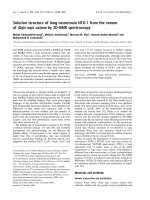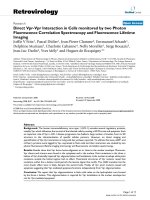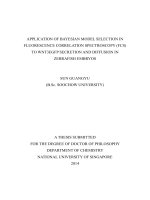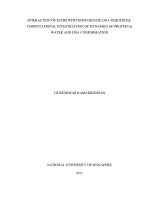Investigation of peptide lipid interaction by fluorescence correlation spectroscopy
Bạn đang xem bản rút gọn của tài liệu. Xem và tải ngay bản đầy đủ của tài liệu tại đây (4.43 MB, 160 trang )
INVESTIGATIONOFPEPTIDE‐LIPID
INTERACTIONBYFLUORESCENCE
CORRELATIONSPECTROSCOPY
GUOLIN
(B.Sc.)
ATHESISSUBMITTEDFORTHEDEGREEOF
DOCTOROFPHILOSOPHY
DEPARTMENTOFCHEMISTRY
NATIONALUNIVERSITYOFSINGAPORE
2010
InvestigationofPeptide‐LipidInteractionbyFluorescenceCorrelationSpectroscopy
I
This work was performed in the Biophysical Fluorescence Laboratory, Department of
Chemistry,NationalUniversityofSingaporeunderthesupervisionofAssociateProfessor
ThorstenWohland.
Theresultshavebeenpartlypublishedin:
Guo,L.,J.Y.Har,J.Sankaran,Y.Hong,B.KannanandT.Wohland(2008)."Molecular
diffusionmeasurementinlipidbilayersoverwideconcentrationranges:a
comparativestudy."Chemphyschem9(5):721‐8.
Kannan,B.,L.Guo,T.Sudhaharan,S.Ahmed,I.MaruyamaandT.Wohland(2007).
"Spatiallyresolvedtotalinternalreflectionfluorescencecorrelationmicroscopy
usinganelectronmultiplyingcharge‐coupleddevicecamera."AnalChem79(12):
4463‐70.
Yu,L.,L.Guo,J.L.Ding,B.Ho,S.S.Feng,J.Popplewell,M.SwannandT.Wohland
(2009)."Interactionofanartificialantimicrobialpeptidewithlipid
membranes."BiochimBiophysActa1788(2):333‐44.
Leptihn,S.,L.Guo,V.Frecer,B.HoandJ.Ding(2010)."Onestepatatime:Action
mechanismofSushi1antimicrobialpeptideandderivedmolecules."Virulence
1(1):42‐44.
Sankaran,J.,M.Manna,L.Guo,R.KrautandT.Wohland(2009)."Diffusion,transport,
andcellmembraneorganizationinvestigatedbyimagingfluorescencecross‐
correlationspectroscopy."BiophysJ97(9):2630‐9.
InvestigationofPeptide‐LipidInteractionbyFluorescenceCorrelationSpectroscopy
II
Acknowledgement
Adoctoralthesislikethis,involvingvariousfields,wouldnotbepossiblewithout
the help of many people. I would like to take this opportunity to acknowledge the
personswhoprovidedgreathelpinmystudy.
First, I would like to acknowledge my supervisor Associate Professor Thorsten
Wohland from Department of Chemistry for providing such an interesting research
project.Iamalsogratefulforhisinvaluableguidance,supportandpatiencethroughout
theproject.
I would like to thank Professor Ding Jeak Ling from Department of Biological
Science and Associate Professor Ho Bow from Department of Microbiology for their
scientificsuggestionsanddiscussionsontheproject.
I am also grateful to all mycolleagues from Biophysical Fluorescence Laboratory
fortheirkindhelpandsupport.EspeciallyLanlanYuforhergreatadvicesontheproject
ofantimicrobialpeptides;LingChinHwangandXiaotaoPanfortheirhelpfuldiscussions
onFluorescenceCorrelationSpectroscopy;PingLiu,XiankeShi andSebastianLeptihnfor
theirkindsupportonbiologicalrelevanttopics;KannanBalakrishnan,JiaYiHar,Manna
ManojKumar and JagadishSankaran fortheir great helpon theImaging TotalInternal
ReflectionFluorescenceCorrelationSpectroscopyproject.
And last but not least I would like to thank my parents for their understanding,
supportandloveforalltheseyears.
InvestigationofPeptide‐LipidInteractionbyFluorescenceCorrelationSpectroscopy
III
Acknowledgement II
TableofContents III
Summary VII
ListofFigures IX
ListofTables XI
Chapter1 Introduction 1
1.1 IntroductiontoAntimicrobialpeptides 3
1.1.1 Antimicrobialpeptides 5
1.1.1.1 Biologicalactivitiesofantimicrobialpeptides 5
1.1.1.2 Originsofantimicrobial peptides 5
1.1.1.3 Structuralfeaturesofantimicrobialpeptides 8
1.1.1.4 Therapeuticpotentialofantimicrobialpeptides 13
1.1.2 Designedantimicrobialpeptides 13
1.1.2.1 Designedantimicrobialpeptides 15
1.1.2.2 DenovodesignedVpeptidefamily 16
1.1.3 Mechanismofantimicrobialpeptides 18
1.1.3.1 Biologicalmembranes 19
1.1.3.2 Modelmembranes 24
1.1.3.3 Mechanismsofantimicrobialpeptides 26
1.1.3.4 Methodstostudymechanismofantimicrobialpeptides 30
1.2 ConventionalFluorescenceCorrelationSpectroscopy 34
1.2.1 BasicTheory–AutocorrelationFunction 36
1.2.2 BasicSetup‐ConfocalMicroscope 43
1.2.3 CombiningFluorescenceCorrelationSpectroscopywithaLaserScanning
Microscope 44
Chapter2 Investigationofthebindingaffinityofmodifiedantimicrobialpeptideto
membranemimics 46
2.1 Introduction 46
2.2 Materialsandmethods 47
2.2.1 Materials 47
2.2.2 Peptides 47
2.2.3 Smallunilamellarvesicles(SUVs)preparation 48
2.2.4 InteractionofmodifiedV4peptideswithLPS 48
InvestigationofPeptide‐LipidInteractionbyFluorescenceCorrelationSpectroscopy
IV
2.2.5 InteractionofmodifiedV4peptideswithSUVs 48
2.2.6 FCSInstrumentationandconfocalimaging 49
2.3 ResultsandDiscussion 50
2.3.1 CalibrationoftheFCSsetup 50
2.3.2 ModifiedAMPsaremoresolublecomparedwithV4 51
2.3.3 ModifiedantimicrobialpeptidecanbindtoLPSstrongly 55
2.3.4 ModifiedantimicrobialpeptidecanbindtoPOPGstrongly 59
2.3.5 ModifiedantimicrobialpeptidesshowlowbindingaffinitytoPOPC 61
2.3.6 ComparisonbetweendifferentVpeptides 62
Chapter3 Investigationofthemechanismsofantimicrobialpeptidesinteractingwith
membranemimics 66
3.1 Introduction 66
3.2 Materialsandmethods 68
3.2.1 Materials 68
3.2.2 Peptides 68
3.2.3 Fluorophoreentrappingv esiclepreparation 68
3.2.4 Fluorophorelabeledvesiclepreparation 69
3.2.5 InteractionofMV4swithrhodamine6GentrappedLUVs(REVs)andRho‐PE
labeledLUVs(RLVs) 69
3.2.6 FCSinstrumentationandconfocalimaging 69
3.3 Resultsanddiscussion 70
3.3.1 Modifiedantimicrobialpeptidesinduceleakageofrhodamine6Gentrappedin
POPGLUVs 70
3.3.2 ModifiedantimicrobialpeptidesinteractwithRho‐PElabeledPOPGLUVs 74
3.3.3 ModifiedantimicrobialpeptidesinteractwithRho‐PElabeledPOPCLUVs 78
3.3.4 VisualizationofModifiedpeptidesinteractingwithRho‐PElabeledLUVs 79
3.3.5 ComparisonbetweendifferentVpeptides 79
3.4 Confocalvisualizationofpeptide‐lipidinteraction 82
3.4.1 Materialsandmethods 83
3.4.1.1 Materials 83
3.4.1.2 GUVspreparation 83
3.4.1.3 ImmobilizationofGUVsoncoverslide 83
3.4.1.4 Confocalimaging 84
3.4.2 VisualizationofinteractionbetweenV4andGUVs 84
3.5 Invivomeasurements 87
InvestigationofPeptide‐LipidInteractionbyFluorescenceCorrelationSpectroscopy
V
3.5.1 Materialsandmethods 88
3.5.1.1 Peptides 88
3.5.1.2 Preparationofbacterialculture 88
3.5.1.3 Bacterialassay 89
3.5.2 MonitoringtheGFPleakagefromGram‐negativebacteria 89
Chapter4 ImagingTotalInternalReflectionFluorescenceCorrelationSpectroscopyasa
tooltomonitorthepeptide‐lipidinteraction 92
4.1 IntroductiontoITIR‐FCS 92
4.1.1 Totalinternalreflection(TIR)illumination 92
4.1.2 Imagingtotalinternalreflectionfluorescencecorrelationspectroscopy 94
4.1.3 Basicsetup 98
4.1.4 Basictheory‐AutocorrelationfunctionforITIR‐FCS 100
4.2 CharacterizationofITIR‐FCS 102
4.2.1 Introductiontodifferentfluorescencetechniques 103
4.2.1.1 Z‐scanFCS 104
4.2.1.2 Fluorescencerecoveryafterphotobleaching 105
4.2.1.3 Singleparticletracking 107
4.2.2 MaterialsandMethods 109
4.2.2.1 Lipidsanddyes 109
4.2.2.2 Peptides 109
4.2.2.3 PreparationofSLB 109
4.2.2.4 PreparationofGUVs 110
4.2.2.5 ImmobilizationofGUVs 110
4.2.2.6 FCSinstrumentationandmeasurement 110
4.2.2.7 FRAPinstrumentationandmeasurement 111
4.2.2.8 SPTandITIR‐FCSInstrumentation 111
4.2.2.9 SPTmeasurement 111
4.2.2.10 ITIR‐FCSmeasurement 112
4.2.3 ResultsandDiscussion 112
4.2.3.1 Results 112
4.2.3.2 Comparisonofdifferenttechniques 116
4.2.3.3 FeaturesofITIR‐FCS 121
4.3 UtilizingITIR‐FCStoinvestigatethebehaviorofanti microbialpeptidesonlipid
membrane 122
InvestigationofPeptide‐LipidInteractionbyFluorescenceCorrelationSpectroscopy
VI
4.3.1 Introduction 122
4.3.2 MaterialsandMethods 122
4.3.3 ResultsandDiscussion 123
Chapter5 ConclusionsandOutlook 127
5.1 Conclusion 127
5.2 Outlook 131
Reference 134
InvestigationofPeptide‐LipidInteractionbyFluorescenceCorrelationSpectroscopy
VII
Summary
In this work I investigate the action of antimicrobial peptides(AMPs) with single
moleculesensitivefluorescencespectroscopymethods.
AMPsarenovelandpromisingcandidatesofantibiotics.AMPskillthepathogenby
permeabilizingthe bacterialmembrane. Soit is veryhard forbacteria to developdrug
resistance. De novo designed AMPs can greatly enlarge the pool of available peptide
candidates,eliminatingsomeofthecytotoxicfeaturesofthenaturalones.Asadenovo
designedpeptide,V4originatedfromaLPS(lipopolysaccharide)‐bindingmotif,showed
itsgoodcombinationofstrongantimicrobialeffectandlowcytotoxic/hemolyticeffect.
However,itsapplicationislimitedduetoitslowsolubility.Toovercomethislimitation,a
seriesofmodifiedV4(MV4s)wasdesignedtohavebettersolubility.
Inthisstudy,theinteractionbetweenMV4sanddifferentlipidmodelmembranes
was investigated using single molecule sensitive fluorescence spectroscopy methods,
suchasfluorescencecorrelationspectroscopy(FCS)andimagingtotalinternalreflection
fluorescence correlation spectroscopy (ITIR‐FCS), togetherwith laser scanning confocal
imaging. A similar mechanism of MV4s compared to V4 was observed: inducing lipid
aggregation before inducing the lipid membranes disruption. By comparing different
MV4s, we found that a) highly positively charged structure maintained preferential
bindingtonegativelychargedlipid,b)higherhydrophobicitygave risetoahigheractivity
againstbothnegativelychargedandzwitterioniclipid,andc)twobindingmotifsinMV4s
mayplay acrucialrole tomaintaintheiractivity.Agoodconsistencywasfoundbetween
predicted and actual property of peptides. Further study of AMPs on live E. coli
InvestigationofPeptide‐LipidInteractionbyFluorescenceCorrelationSpectroscopy
VIII
suggestedthatpeptideswithmediumhydrophobicityshowedthehighestantimicrobial
activity.
ByinvestigatingdifferentmembersoftheV4peptidefamily,thisstudycontributes
toourunderstandingoftheirmechanismofantimicrobialactivityandselectivity.Itthus
providesfurtherguidelinesfortherationaldesignofantimicrobialpeptides.
InvestigationofPeptide‐LipidInteractionbyFluorescenceCorrelationSpectroscopy
IX
ListofFigures
Fig1.1SchematicrepresentationoftheGram‐negativebacteriacellwall. 20
Fig1.2SchematicrepresentationofcellwallfromGram‐positivebacteria. 20
Fig1.3StructureoflipidA. 21
Fig1.4Schematicdrawingofdifferentmodelmembrane. 26
Fig1.5Thebarrel‐stavemodel. 27
Fig1.6Thecarpetmodel. 28
Fig1.7Thetoroidalmodel. 29
Fig1.8PrincipleofFCS. 37
Fig1.9PrincipleofACFcurves. 41
Fig1.10SchematicdrawingofatypicalFCSsetup 43
Fig2.1Principleofaffinitymeasurement. 47
Fig2.2ComparisonbetweenTV4‐TMRandTMR. 52
Fig2.3ComparisonbetweenV4norv‐TMR,V4abu‐TMR,V4ala‐TMRandTMR. 52
Fig2.4ACFandintensitytraceobtainedforV4norv‐TMR. 53
Fig2.5ConfocalimageofV4norv‐TMR. 55
Fig2.6ACFobtainedforV4ala‐TMR. 55
Fig2.7ACFcurvesobtainedfortitratingLPSintodifferentpeptides . 57
Fig2.8InteractionbetweenLPSanddifferentpeptides. 57
Fig2.9LPSdissolvedthepeptideaggregates. 58
Fig2.10V4norv‐TMR,V4abu‐TMR,V4ala‐TMRinteractingwithPOPGSUVs. 60
Fig2.11TV4showedalmostnoaffinitytoPOPGSUVs. 61
Fig2.12bindingaffinityofdifferentMV4‐TMRtoPOPGSUVs. 61
Fig2.13MV4sshowedalmostnoaffinitytoPOPCSUVs. 63
Fig3.1Principleofleakagemeasurement. 67
Fig3.2Principleofdisruptionmeasurement. 67
Fig3.3ComparisonbetweenPOPGREVandfreeR6G. 70
InvestigationofPeptide‐LipidInteractionbyFluorescenceCorrelationSpectroscopy
X
Fig3.4InteractionbetweendifferentpeptidesandPOPGREVs. 73
Fig3.5DifferentpeptidesshoweddifferentactivityagainstPOPGREVs. 74
Fig3.6InteractionbetweendifferentpeptidesandPOPGRLVs. 75
Fig3.7ACFandintensitytraceforPOPGRLVaggregatesandfragments. 76
Fig3.8DifferentpeptidesshoweddifferentactivityagainstPOPGRLVs. 77
Fig3.9InteractionofMV4swithPOPCRLVs. 78
Fig3.10ConfocalimagesofRLVsinteractingwithMV4. 82
Fig3.11ActivityagainstdifferentlipidsforMV4s. 83
Fig3.12V4evenlyandreversiblyboundonPOPCGUVs. 86
Fig3.13V4rapidlydisruptedPOPGGUVs. 87
Fig3.14PeptidesactivityagainstE.coli. 90
Fig4.1Totalinternalreflection. 93
Fig4.2Schematicdrawingofaprism‐basedTIR‐FCSsetup. 96
Fig4.3Schematicdrawingofanobjective‐basedTIR‐FCSsetup. 97
Fig4.4SchematicdrawingofITRF‐FCSsetupusedinthestudy. 99
Fig4.5Schematicrepresentationonz‐scanFCS. 104
Fig4.6SchematicillustrationofFRAPmeasurement. 106
Fig4.7SchematicillustrationonthecalculationofMSD. 108
Fig4.8Dataobtainedusingdifferentfluorescencetechniques. 114
Fig4.9HistogramofdiffusioncoefficientobtainedbySPT. 115
Fig4.10Dependenceofthelateraldiffusiontimeonthez‐positionofthefocus. 115
Fig4.11Comparisonofthediffusioncoefficientsobtainedwithdifferenttechniques. 119
Fig4.12AnexampleofACFcurvesobtainedusingITIR‐FCSsetup. 124
Fig4.13OnesetofITIR‐FCSresult. 125
Fig4.14AnothersetofITIR‐FCSdatashowingdifferentresult. 125
Fig4.15TIRFimageofunevendistributionofV4. 126
InvestigationofPeptide‐LipidInteractionbyFluorescenceCorrelationSpectroscopy
XI
ListofTables
Table1.1Clinicaldevelopmentsofcationicantimicrobialpeptides. 14
Table1.2PredictedmolecularpropertiesofmodifiedV4. 18
Table2.1ComparisonbetweendifferentMV4‐TMRandTMR. 53
Table2.2DifferentMV4‐TMRuponsaturationbindingwithLPS. 59
Table2.3ComparisonofdifferentMV4‐TMRinteractingwithPOPGSUVs. 60
Table2.4MV4sshowedalmostnoaffinitytoPOPCSUVs. 62
Table4.1ITIR‐FCSresultsobtainedusingdifferentfittingmodelatvariousbinning. 116
Table4.2Comparisonoftheworkingconcentrationandareaof4differenttechniques. 117
Table4.3ComparisonofFCS,FRAP,SPTandITIR‐FCSresults. 120
InvestigationofPeptide‐LipidInteractionbyFluorescenceCorrelationSpectroscopy
1
Chapter1 Introduction
Due to drug resistance developed by bacteria, treatment of bacterial infections
using conventional antibiotics is facing a serious challenge. Antimicrobial peptides
(AMPs) are considered to be promising candidates for solving the problem of drug
resistance. By directly targeting the membrane of the bacteria rather than proteins
crucial for bacteria survival, it is much harder for bacteria to develop drug resistance
sinceachangeinthemembranecompositionwouldalsorequirecorrespondingchanges
in many membrane related proteins. However, due to their lack of selectivity, the
pharmaceuticalapplicationofnatural encodedAMPsislimited.Alternatively,designed
AMPs are able to overcome this problem. Nowadays, different mutations of natural
AMPscanbeeasilysynthesizedandtestedagainstdifferentbacterialstrainsinorderto
find AMPs with better selectivity. De novo designing of AMPs using computational
simulationfurtherenlargethepoolofavailablepeptidecandidates.
In a previous study (Freceret al. 2004) a series of de novo designed AMPs was
proposed.TheseAMPshaveacommonmotifofHBHPHBH(H:hydrophobic;B:basic;P:
polar)derived froma LA‐ (lipid A) or LPS‐ (lipopolysaccharide) binding pattern.Among
the7designedpeptides,V4hasthebestcombinationofhighantimicrobialactivity,low
cytotoxicandlowhemolyticactivity.Howeveritsapplicationislimitedduetoitsstrong
hydrophobicityasshowninpreviousstudy(Yuetal.2005).Toovercomethislimitation,
modificationsofV4peptideswereproposedinthecurrentstudy.Fluorescenceimaging
and spectroscopy were used in this study to investigate how peptides interact with
differentmembranesystem.Morespecifically,theaimsare:
To investigate how different hydrophobicity would affect the solubility of the
InvestigationofPeptide‐LipidInteractionbyFluorescenceCorrelationSpectroscopy
2
peptides.
To study the binding affinity of modified V4 to LPS on the outer membrane of
Gram‐negative bacteria, and different phospholipids liposomes which mimic
different cytoplasmic membranes to elucidate the membrane activity and
specificityofdifferentpeptides.
To compare the ability to induce membrane permeabilization for different
peptides.
To extend previous in vitro work to in vivo (measurement on Gram‐negative
bacteria) from which morebiological relevant results on activity of the peptides
willbeprovided.
To elucidate the possible mechanisms of interaction between AMP and
membranes.
Toapplynewtechniques(imagingtotalinternalreflectionfluorescencecorrelation
spectroscopy)tostudythepeptide‐lipidinteraction.
The study is aimed to enhance the understanding of the specificity of the V
peptide family and their mode of action on membranes. It may also provide more
evidence for the hypothetic mechanism of interaction between V peptides and lipid
membranes.Moreover,theresultscouldcontributetotherationaleofdesigningnovel
antimicrobialdrugsandprovideusefulinformationconcerningnewantimicrobialdrugs.
Information on the mechanism of the interaction between AMPs and lipid
membranes can be provided by fluorescence correlation spectroscopy (FCS), which is
the main technique used in this study. However FCS cannot distinguish between
insertion and adsorption when peptides interact with lipid membranes. Moreover
investigation could be performedon different typesand strains of Gram‐negative and
InvestigationofPeptide‐LipidInteractionbyFluorescenceCorrelationSpectroscopy
3
Gram‐positive bacteria, providing a much more comprehensive idea on the effect of
AMPsondifferentbacteria.
Inthisthesisfluorescenceimagingandspectroscopyareprovedtobeusefultools
to study the interactions between AMPs and membranes and related mechanism.
Differentmembranemodelsareappliedinthisstudy,includingmicelles,smallandlarge
unilamellar vesicles (liposomes). Micelles and small unilamellar vesicles are used for
investigating the binding affinity of peptides (chapter 2) and large unilamellar vesicles
areusedtostudymembranepermeation(chapter3).Detailsinthemethodologywillbe
presented in each related chapter. In chapter 4, a recently developed method called
imagingtotalinternalreflectionfluorescencecorrelationspectroscopy(ITIR‐FCS) willbe
characterized and applied to peptide‐lipid interaction study. A final conclusion of this
studywillbepresentedinchapter5includinganoutlookonfuturework.
In chapter 1.1, previous studies on AMPs will first be reviewed, including the
general introduction of AMPs, de novo designed AMPs and proposed mechanisms of
peptide‐lipidinteraction.Afterthat,FCSasthemaintechniqueusedinthisstudywillbe
discussedindetail.
1.1 IntroductiontoAntimicrobialpeptides
Sincetheearly1900s,thewideusageofantibioticsalmostwipedoutalldiseases
caused by bacterial infection (Breithaupt 1999). The discovery of antibiotics has
drasticallyincreasedhumanlifeexpectancy.Butduetoindiscriminateuseofantibiotics,
bacteria develop multiple resistances to the currently available antibiotics (Breithaupt
1999; Lee 2008). The fact that bacteria can exchange plasmids, hence spread drug
InvestigationofPeptide‐LipidInteractionbyFluorescenceCorrelationSpectroscopy
4
resistance further exacerbates the situation (Hughes et al. 1983). On the other hand,
onlyafewclassesofantibioticshavebeenapprovedforclinicaluseinthelastfewyears,
including daptomycin, tigecycline and linezolid (Lee 2008). In some cases due to the
multi‐drugresistantpathogen,thetreatmentappearstogobacktothesocalled“pre‐
antibioticera”(Breithaupt1999;Lee2008).
Inthelastdecade,AMPshavebecomepromisingcandidatesfornovelantibiotics
(Breithaupt1999; McPheeetal.2005).AMPsaresmall,withupto50aminoacids,and
usually positively charged (due toarginine, lysine, or histidine in acidic condition) and
amphiphathic (contains >50% hydrophobic aminoacids) (Reddy etal. 2004; Gordon et
al. 2005). More information on AMPs can be found in the following section (1.1.1)
includingorigins,structuralfeaturesandtherapeuticpotentialofAMPs.
Normal antibiotics, which are usually bacteriostatic (prevent bacterial growth),
workbyinhibitingthesynthesisofbacterialcellwallorproteinswhichareessentialfor
cellgrowth.Ontheotherhand,AMPsbeingbactericidalkillbacteriadirectly.However
due to their lack of selectivity they are limited in pharmaceutical use, even though
designedAMPscanpossiblyovercomethislimitation(Freceretal.2004)(referto1.1.2).
AMPs kill bacteria (Andreu et al. 1998; Sitaram et al. 1999) by permeablizing the
membrane, so it is unlikely forbacteria todevelop drug resistancesince they have to
adapt themselves to the new drug by evolving newmembranes together with related
proteins. More recently, researchers also found that AMPs are also involved in the
immunomodulation acting as cytokines to modulate the adaptive immune response
(Brogden 2005). But in general, the mechanism of AMPs is still unclear, and further
investigationisneeded.
InvestigationofPeptide‐LipidInteractionbyFluorescenceCorrelationSpectroscopy
5
1.1.1 Antimicrobialpeptides
1.1.1.1 Biologicalactivitiesofantimicrobialpeptides
AMPsareancientdefensemoleculeswhichhave evolved overatleast2.6billion
years. Nowadays AMPs still remain effective as defensive weapons. The existence of
AMPs throughout the evolution disconfirm the idea that bacteria are able to develop
resistancetoanyfeasibledrugs(Zasloff2002).AMPshaveaverybroadspectrumagainst
different microbes, including Gram‐negative bacteria, Gram‐positive bacteria, viruses,
fungi and cancercells (Reddy et al. 2004), withvarious mode ofaction (Zasloff 2002).
AMPs can be found in different organism and species, including insects, amphibians,
mammals and plants, where they act as the first component to defend hosts from
pathogeninvasion.Inhighervertebrates,thisiscomplementedbytheresponseofthe
adaptive immune system which usually acts several days after bacterial infection
(Hancocketal.1998;Breithaupt1999).
1.1.1.2 Originsofantimicrobialpeptides
AMPs are present in a wide range of organisms.Till now, almost 1500 different
AMPs have been identified or predicted from nucleic acid sequences
( />).Thissectionwill brieflyreviewaselectiverangeof
peptidesoriginating frommammals, amphibians, insects, crustaceans, plants,bacteria,
andviruses.
PeptidesfromMammals
ThemoststudiedmammalianAMPsaredefensins(Hancocketal.1999;Ganz2003;
Oppenheim et al. 2003). Defensins are divided into two main subfamilies, namely α‐
defensinsand β‐defensins. Inmammals, α‐defensinsare mainlypresent in neutrophils
InvestigationofPeptide‐LipidInteractionbyFluorescenceCorrelationSpectroscopy
6
and paneth cells,and the β‐defensinsare expressed in epithelial cells and leukocytes.
Both α‐ and β‐defensins have high arginine content.6 cysteine residues form
intramolecular disulfide bridges resulting in a triple ‐stranded β‐sheet structure
connected by a loop with a β‐hairpin hydrophobic finger. But the length of peptide
segmentsbetweencysteinesandpairingofthecysteinesaredifferentinthetwogroups.
Apart from α‐ and β‐defensins, another subgroup of defensins withdistinct structure
calledθ‐defensinhasbeenidentified(Tangetal.1999).Byanunknownprocess,cyclicθ‐
defensin is generated by splicing and cyclization of an α‐defensin‐like precursor.
Peptidesoriginatingfromhuman,suchascathelicidins,histatinsandprotegrins(Reddy
etal.2004;DeSmetetal.2005)werealsofound.Peptidesfromthefamilyofhistatins
aresmall,cationic,histidine‐richpeptidesisolatedfromhumansaliva.Cathelicidin(LL‐37)
isderivedproteolyticallyfromtheC‐terminalendofthehumanCAP18protein.Histatins
andcathelicidinsformanα‐helicalstructureinahydrophobicenvironment.
Peptidesfromamphibians
FromthefirstdiscoveredAMPbombinin(Kissetal.1962;Csordasetal.1970),a
largenumberofAMPshavebeenidentifiedfromamphibians,includingmagainins.One
characteristicofamphibianpeptidesisthattheytendtolacksequencesimilarity(Kreil
1994).ThereisnohomologybetweenAMPsfromonespeciestoanother.However,all
amphibian peptides are predicted to form cationic amphipathic α‐helices (magainins,
dermaseptins,andbuforinII),orcysteine‐disulfideloops(ranalexinandbrevinins).
PeptidesfromInsects
SincethefirstcharacterizationofanAMPinmoth(Steineretal.1981),morethan
170peptideshavebeenidentifiedfromdifferentinsects(Buletetal.1999).InsectAMPs
InvestigationofPeptide‐LipidInteractionbyFluorescenceCorrelationSpectroscopy
7
are divided into two groups basedon their sources,namelypeptides expressed inside
thebody(cecropinfrommothhaemolymph)(Hultmarketal.1980)oroutsidethebody
(melittin from bee venoms) (Habermann 1972). Different insects generate a series of
AMPs when theysuffer an injury. Drosophila (drosophila melanogaster), for example,
contains 7 different AMPs in its hemolymph, namely drosomycin, cecropin, drosocin,
metchnikowin, defensin, diptericin and attacin (Hergannan et al. 1997). 15 peptides,
named ponericins, were isolated from the venom of a certain subfamily of ant called
Pachycondyla goeldii (Orivel et al. 2001), which show similarity with peptides such as
cecropins, melittins and dermaseptins. One interesting finding is that Drosophila can
differentially express several AMPs in response to various classes of microorganisms,
andalsoshowadaptedresponseto entomopathogenicfungibyproducingonlypepti des
withantifungalactivities(Lemaitreetal.1997).Morerecently(Leeetal.1989;Boman
1995),thebroaderdistributionofcecropinwasrevealedbythediscoveryofmammalian
cecropininporcinesmallintestine.
Peptidefromothersources
AMPs have also been isolated from other sources, such as crustaceans, plants,
bacteria, and viruses. Tachyplesin, polyphemusin, big defensin and tachycitin were
isolatedfromdifferentspeciesofhorseshoecrabs(Nakamuraetal.1988;Miyataetal.
1989;Saitoetal.1995;Kawabataetal.1996).Androctonin(Ehret‐Sabatieretal.1996)
andpenaeidin(Destoumieuxetal.2000)wereisolatedfromcrustaceansshrimp,oreven
fromscorpion.Thoininfromanumberofplantspecies(Floracketal.1994),bacteriocins
(Hancock et al. 1999) from Gram‐positive and Gram‐negative bacteria and LLPs from
virus(Tenczaetal.1997)areidentified.
InvestigationofPeptide‐LipidInteractionbyFluorescenceCorrelationSpectroscopy
8
Other promising sources of AMPs are synthetic peptides. A series of AMPs have
beensynthesizedbymodifyingthesequenceoftheirnaturalanalogues,oraccordingto
apredictionofamphipathicstructure.The ultimategoalsofinvestigationsonsynthetic
AMPsaretoproduceAMPswithhigherantimicrobialactivitiesandtogainmoreinsight
intothemechanismofAMPsinteractingwithlivingcells.
1.1.1.3 Structuralfeaturesofantimicrobialpeptides
WithinAMPsfromthesamethespeciesorhighertaxonomiclevels,theconserved
sequences are considered to regulate the translation, secretion and trafficking of the
peptides(Zasloff2002).However,diversityinthesequencesof AMPs ishighsuchthat
thesamepeptidesequenceisrarelyconservedintwodifferentspecies,evenwhenthey
are closely related.This diversity of AMP sequences indicatesadaptation of different
species to the environment. The biological activity of individual peptides can be
dramatically changed by a single mutation in its sequence. Thus the species could
surviveby emergence of beneficialmutations from differentindividuals (Zasloff 2002).
Due to the great diversity in AMPs, we can only categorize them based on their
structural features. Different reviews have provided various classifications based on
different criteria (Boman 1995; Blondelle et al. 1999; Epand et al. 1999; Reddy et al.
2004; Brogden 2005; McPhee et al. 2005). In this work, AMPs will be categorized
accordingtotheirsecondarystructure.
α
‐helicalantimicrobialpeptides
Cationic linear α‐helical AMPs may be the most widely spread and best
characterizedpeptides,includingmelittin,magainin,cecropin,cathelicidin(Blondelleet
al.1999;McPheeetal.2005)aswellasanumberofdenovodesignedAMPs(Datheet
InvestigationofPeptide‐LipidInteractionbyFluorescenceCorrelationSpectroscopy
9
al. 1996; Dathe et al. 1997; Wieprecht et al. 1997; Dathe et al. 2002). In aqueous
solution, many of these peptides exist in a disordered structure. However upon
interaction with hydrophobic solvents or surfaces such as trifluoroethanol, sodium
dodecyl sulphate (SDS) micelles or phospholipid vesicles, they fold into an α‐helical
conformation. α‐helical peptides are often found to be amphipathic, and thus can
adsorb onto bacterial membrane surfaces and insert into the lipid membranes as a
cluster of helical bundles. However, there are also α‐helical peptides that are
hydrophobic(gramicidinA)orevenslightlyanionic(alamethicin)(Epandetal.1999).In
general,anamphipathichelicalstructureisconsideredtobeimportantforantimicrobial
andcytotoxicactivity.Forexamplemagaininlosesitshelicalstructureandantimicrobial
activity when only few amino acids were replaced with their D‐isomers (Chen et al.
1988),eventhoughexceptionstothisdoexist.ByaddingsomeD‐aminoacidresidues,
α‐helical pardaxin (Oren et al. 1999) was converted to β‐structure, losing hemolytic
activity but keeping antimicrobial activity. Thus the structure‐activity relation is still
underdebate.
β
‐sheetantimicrobialpeptides
Thesepeptidesconstitutealargefamilyofcyclicpeptidesinthepresenceoftwo
ormoreβ‐strandsstabilizedbyoneormoreintramoleculardisulfidebonds.Inaqueous
solutiontheymainly existas β‐sheets,whicharefurtherstabilizeduponinteractionwith
lipid surfaces(Blondelle et al. 1999). Among all β‐sheet AMPs, defensins are the best‐
characterized subgroup. Both α‐defensins and β‐defensins contain 3 β‐strands and 6
cysteineswhichform3disulfidebonds,namelybetweenC1‐C6(disulfidebondbetween
1
st
cysteineand6
th
cysteine),C2‐C4,C3‐C5forα‐defensinsandC1‐C5,C2‐C4,C3‐C6for
InvestigationofPeptide‐LipidInteractionbyFluorescenceCorrelationSpectroscopy
10
β‐defensins(McPheeetal.2005).Anotherfamilycalledθ‐defensinsdiscoveredin1999
iscyclic(Tangetal.1999).
β
‐hairpinantimicrobialpeptides
β‐hairpin AMPs form a hairpin like structure composed of antiparallel β‐strands
interconnectedbyβ‐turns(Reddyetal.2004).Similartoβ‐sheetAMPs,thestructureof
β‐hairpinAMPsisalsostabilizedby1‐2disulfide bondsbetweenβ‐strands.Tachyplesins
and polyphemusins isolated from horseshoe crabs show a typical β‐hairpin structure
stabilizedbytwodisulfidebonds(Laederachetal.2002;Powersetal.2004).Theyshow
antimicrobial activity against both Gram‐negative and Gram‐positive bacteria, and
antifungal activity (Miyata et al. 1989; Tam et al. 2002). Protegrins from porcine
neutropilsalsoshowasimilarstructure(Harwigetal.1995).Thanatinsfrominsectsand
lactoferricinsderivedfromlactoferrin adopta β‐hairpinstructure stabilizedby a single
disulfidebond(Hwangetal.1998;Mandardetal.1998).
Cyclicantimicrobialpeptides
Asubgroupofthesepeptidesmayrelatetoβ‐hairpinAMPs,e.g.bactenecinsfrom
cattleneutrophilsarecyclicpeptidescontainingonedisulphidebondandaβ‐turn.There
are also peptides whose backbones are covalently cyclized, such as gramicidin S and
polymyxinB(Hancocketal.1999).
Extendedantimicrobialpeptides
ExtendedAMPsareaclassofpeptideslackingatypicalsecondarystructure.They
areusuallyrichinoneormorespecificaminoacids(McPheeetal.2005).Tritrpticinsand
indolicidins are examplesof this class. Theyare rich in tryptophan residues, namely 3
and5tryptophanresiduesintheirtotal13aminoacids.Theyformaboat‐likestructure
whenbindingtodiphosphatidylcholine(DPC)(Schiblietal.1999;Rozeketal.2000).The
InvestigationofPeptide‐LipidInteractionbyFluorescenceCorrelationSpectroscopy
11
tryptophan‐rich region in the middle of the peptides interacts with one layer of the
membrane, and orients the two termini toward the aqueous environment. Other
peptides, such as histatin isolated from human saliva is rich in histidine residues (18‐
29%) and highly cationic (De Smet et al. 2005). Bac‐5 and Bac‐7 identified in bovine
neutropilsare rich in proline. PR‐39foundin porcineneutrophils is rich in proline and
arginine(Agerberthetal.1991).Peptidesrichinglycine canbefoundinamphibiansand
insects (Otvos 2000; Orivel et al. 2001). Glycine‐rich peptides may show structural
similaritytopeptidessuchasmelittin,cecropinorattacin.
Although AMPs show large variation in their structures, they do share some
commonfeatures(Brogden2005).
(1)TheusualsizeofAMPsissmall,andrangesfrom6to59aminoacids.
(2) Most natural AMPs arepositively charged. Theyare cationic peptides rich in
arginineandlysine.Thenetchargeusuallyrangesfrom+2to+9andvarieswithpH.The
positive charge facilitates the selective binding of peptides to negatively charged
membranesofbothGram‐positiveandGram‐negativebacteria.Anionicpeptidesrichin
asparticandglutamicacidsalsoexist.However,alocalcationicpartisneededtointeract
withnegatively chargedlipids. Subtilosin A is an anionic peptide, though itslysine‐rich
part facilitates its binding to the lipid membrane (Thennarasu et al. 2005). Anionic
peptides complexed with zinc or highly cationic peptides are often more active than
neutral peptides or those witha lower charge. However there is no direct correlation
between the number and position of positive charged amino acids and antimicrobial
activity and specificity. Highly cationic peptides may have lower or even lose
antimicrobialactivity(Datheetal.1999).Theoptimalchargewasfoundtobebetween
+4and+6(Tossietal.2000).
InvestigationofPeptide‐LipidInteractionbyFluorescenceCorrelationSpectroscopy
12
(3)Studieshave shownthatamphipathicityofAMPsis crucialregardlessoftheir
secondarystructure (Blondelle et al. 1992; Dathe etal. 1999; Kondejewski et al.1999;
Parketal.2005).InanAMP,hydrophilicaminoacidresiduesarelocatedononesideof
thepeptidemoleculeandhydrophobicaminoacidsarelocatedontheoppositeside.For
α‐helicalpeptides,amphipathicityisoftendefinedasthevectorsumofhydrophobicity
indices, which indicates the spatial separation between hydrophilic and hydrophobic
side chains. Usually, increasing amphipathicity can lead to an increasing hemolytic
activity and decreasing antimicrobial activity (Dathe et al. 1999; Kondejewski et al.
1999).
(4) The hydrophobic faces of the molecule enable soluble peptides in aqueous
solutiontopartitionintohydrophobiclipidbilayers.Thushydrophobicityisexpectedto
strongly regulate membrane activity of AMPs. Hydrophobicity is expressed as the
averageofthenumerichydrophobicityvaluesofallaminoacidresidues(Eisenbergetal.
1984).Increasinghydrophobicityisrelatedtoanenhancedhemolyticeffect(Datheetal.
1999). However, the relation between hydrophobicity and antimicrobial activityis still
debated.
(5) As mentioned above, AMPs can adopt a series of secondary structures.
Peptides with α‐helix and γ‐core motif (defensin‐like structure) often show higher
activity compared to those withless‐defined structures. For α‐helical peptides,higher
helicitycanfacilitateabetterspatialdistributionofhydrophobicandhydrophilicamino
acids, resulting in higher amphipathicity. However, in designing an AMP, helicity is
always closely related to both amphipathicity and hydrophobicity. The reduction of
disulfide bonds presented in β‐sheet structures may change the activity or even
mechanismoftheinteractionofpeptides(Andreuetal.1998).
InvestigationofPeptide‐LipidInteractionbyFluorescenceCorrelationSpectroscopy
13
1.1.1.4 Therapeuticpotentialofantimicrobialpeptides
Considering the possibilities of thousands of natural peptides and millions of
syntheticpeptides,relativelyfewpeptideshaveprogressedintoclinical trialsdespitethe
promising in vitro and animal tests. Although most researchers are optimistic, the
commercialvalueofthesepeptidesremainsambiguous.AlistofAMPsinclinicaltrials
wasreviewed(Hancock1997;Zasloff2002;Andresetal.2004)(Table1.1),eventhough
noneofthepeptideshasbeengrantedFDAapproval,forexampleduetolackofhigher
antimicrobialactivitycomparedtoconventionalantibiotics(Gordonetal.2005).
Withhighoccurrenceofbacterialresistancetowardsantibiotics,itisurgentneed
for discovering and developing novel classes of drugs to control bacterial infections.
AMPs which target the membrane make it difficult for bacteria to develop drug
resistance,andhencearepromisingcandidatestoachievethistarget.
1.1.2 Designedantimicrobialpeptides
TheprevioussectionbrieflyinducesresearchesonnaturalAMPsrecently.Alarge
numbers of natural AMPshave been identified whichshow a broad spectrum against
differentpathogens. For example,magaininsshow antimicrobialactivity againstGram‐
positive and Gram‐negative bacteria, fungi, protozoa and even viruses (Zasloff 1987;
Zasloff et al. 1988; Schuster et al. 1992). Gramicidin S, also show good performance
againstGram‐positiveandGram‐negativebacteria,andcertainfungi(Kondejewskietal.
1996; Prenner et al. 1999). However natural AMPs are often cytotoxic against
mammalian cells, and this limits their potential in pharmaceutical applications. Thus
large efforts have been undertaken to modify native AMPs or design new synthetic
peptidesinordertoobtainAMPsshowingbetterspecificityagainstmicrobeswithlower









